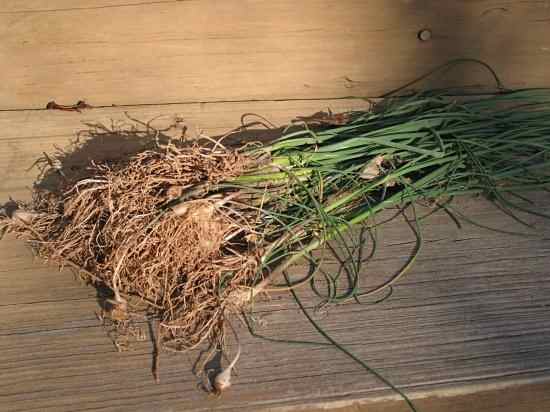How to Get Rid of Onion Grass in Yard
Ryan is an academic coach at Central Connecticut State University, currently pursuing a Master's in Student Development in Higher Education.

This is a close-up showing the bulbs and small root system of onion grass.
fotothing.com
Some "Weeds" Are Actually Edible Wild Plants
The edible plants we find on our grocery store shelves are all familiar to us. Every image of their origins involves neatly set rows in farmers' fields or spotlessly clean stacks in a plastic-smelling, air-contained atmosphere. By eating them, we get about as close to them as we can get, yet, somehow, we forget that the foods were once wild plants. Some were even considered weeds.
One such example is wild onion grass. It is hard to control and invasive in gardens. For that reason, many gardeners seek help getting rid of onion grass. So how do you get rid of it? And why? This article explores the option of controlling and growing onion grass to eat or getting rid of it once and for all.
What Is Onion Grass?
Onion grass is very similar to garlic, onion, and chive. They are all part of the bulbous family. It is unique to its cousins in that it is widely considered an invasive weed.
Common Grass Weeds
Beautifully groomed lawns have one common denominator: They are weed free. A weed is a general term for any plant that a grower finds undesirable. Maybe the plant is ugly, in the case of crabgrass; beautiful but inedible, like clover; or beautiful and edible but invasive, like most types of sunflower.
In some cases, the title of "weed" is arbitrary. Mint is a wild and invasive weed to most gardeners. But I grow mint in my backyard garden, and I use it to make tea. Onion grass is another such example of the gray area between plant and weed.
Parts of the Onion Grass Plant
Onion grass, as part of the bulbous family, has a few distinct features to plants in other families.
- Bulbs beneath the surface: For starters, it contains bulbs under the surface, just above the small root system, with which it reproduces.
- Tube-shaped leaves: Its leaves are shaped like tubes. The leaves are also thin and long, giving it a grass-like appearance (see above for a photo of the bulbs and roots).
- Aromatic, flavorful leaves: The leaves also give it its wonderful aroma and flavor. It shares a similar flavor with its relatives. They can be used much like chives, although with less crunchiness.
Onion grass differs, however, in that it is invasive. If not properly maintained, it will run wild and easily overtake a garden or lawn and steal valuable nutrients for other plants and grasses.

Notice how the leaves grow from underground, much like grass.
Ryan Buda
Read More From Dengarden
How Do You Get Rid of Wild Onion Grass in Your Lawn?
If growing and eating onion grass is not for you, there are ways to control and, hopefully, kill it for good.
Method 1: Pull Out the Bulbs
The first option for getting rid of wild onion grass is to pull it out like you would any other weed. But make sure to focus on getting the bulbs out. It's easy to just focus on the green part that shoots above ground, but, as mentioned earlier, the bulb is responsible for propagating the plant. Leave the bulb and it will come right back. Digging a little deeper will be more work at first, but in the long run it will save a lot of future headaches.
Method 2: Use Sprays and Weed Killers
The leaves of onion grass present a unique problem. The thin tubular leaves make typical sprays and killers, which are designed for broader leaves, less effective. This means that larger amounts of spray and/or more applications may be needed.
Scotts.com recommends Ortho Weed-B-Gone Max weed killer for small areas and a similar concentrate spray for large areas. Round-Up Ready-to-use weed and grass killer is another good option.
Use these sprays before and after winter because onion grass is a perennial plant. The bulbs hang out underneath the surface throughout winter before growing in spring.

Characteristic tubular leaves of onion grass plants
Ryan Buda
Good Luck With This Edible (Yet Invasive) Plant
Wild onion grass is perfectly good to eat. It comes from the bulbous family and has a similar taste to its relatives, such as chives and onions. It is seldom eaten and is considered a weed because it is invasive. If you choose to get rid of it, you must get rid of the bulbs from which the plant grows. Sprays and weed killers work, too, but certain ones must be used.
This content is accurate and true to the best of the author's knowledge and is not meant to substitute for formal and individualized advice from a qualified professional.
© 2012 Ryan Buda
Joe on July 25, 2012:
You should ALWAYS include the botanically (bi-nomial ) /systemic name as that is the only definitive way of identifying the plant. Common names such as 'onion grass' do not uniquely and unambiguously I'd the plant as they vary from one locality to another, let alone across country / geographic regions.
How to Get Rid of Onion Grass in Yard
Source: https://dengarden.com/gardening/Wild-Plants-What-is-Onion-Grass-and-Wild-Onion-Grass-Control
0 Response to "How to Get Rid of Onion Grass in Yard"
Post a Comment